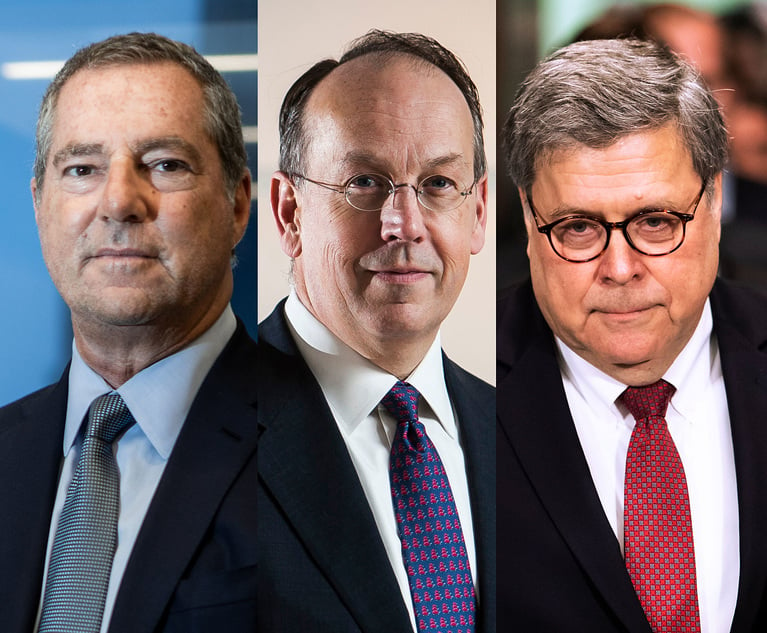Samsung, Paul Hastings Defeat Patent Holder That Vexed Apple
A favorable claim construction ruling from Judge Haywood Gilliam ends a case against a patent owner whose predecessor won $10.7 million from the iPhone maker.
November 19, 2018 at 10:41 AM
3 minute read
 U.S. District Judge Haywood Gilliam, Northern District of California. Photo: Jason Doiy/ALM
U.S. District Judge Haywood Gilliam, Northern District of California. Photo: Jason Doiy/ALM
Samsung has succeeded in beating back a non-practicing entity where Apple failed.
Samsung Electronics Co. Ltd. and Ironworks Patents LLC stipulated to noninfringement and invalidity of two Ironworks smartphone patents last week following a claim construction order from U.S. District Judge Haywood Gilliam of San Francisco last month.
Ironworks' predecessor, MobileMedia Ideas LLC, had asserted the same patents and many others against Apple Inc. a few years ago and wound up winning a $10.7 million judgment in Delaware federal court, albeit on one of the patents not asserted against Samsung.
MobileMedia is an entity formed by MPEG LA, Nokia and Sony in 2010 to license some of their technology. Ironworks acquired the MobileMedia portfolio and took over the Apple and Samsung litigation last year.
Ironworks claimed that Samsung smartphones infringe its 6,427,078 patent, which it describes as the first to claim a tightly integrated multifunctional camera and telephone, and its 5,915,239 patent on a voice-controlled device that can recall stored phone numbers.
Samsung's Paul Hastings team, led by partners Allan Soobert and Elizabeth Brann and associate Steven Moseley, got the case transferred from Florida to the Northern District of California last year. They then argued that the phrase “camera unit” used in the patent must include optics, a microprocessor, memory, a battery and an interface. Samsung's accused products don't meet all those limitations, it argued.
Ironworks, represented by Global IP Law Group and Banys, argued that “camera unit” didn't need to be construed, but if it did, then Gilliam should have used U.S. District Judge Sue Robinson's simple construction from the Apple case: “data collection apparatus for obtaining image information.”
Gilliam pointed to a Federal Circuit ruling from an appeal in that case in which the court implied a more expansive construction. The appellate court observed the “camera unit” is depicted in the claim specification, and the diagram includes optics, a microprocessor and a battery. “This finding tracks Samsung's proposed construction,” Gilliam wrote.
The '239 patent, meanwhile, claims a “means for interpreting the received voice commands,” but doesn't include an algorithm that spells out what the means are. Ironworks argued it wasn't necessary because voice recognition was well-known among persons of skill in the art. But Gilliam pointed to long-standing Federal Circuit case law that “a bare statement that known techniques or methods can be used does not disclose structure.”
Consequently, Ironworks and Samsung moved for a judgment of noninfringement and invalidity, and Ironworks will presumably appeal Gilliam's claim construction to the Federal Circuit. “The court finds that the stipulation is well taken and is hereby granted,” Gilliam wrote in a Thursday order.
Apple was found to have infringed Ironworks' RE39,231 patent, which is related to ring-silencing features.
Correction: A previous version of this article said that Samsung had succeeded in knocking out a patent where Apple had failed. Although MobileMedia Ideas asserted the same three patents against each company, it asserted many additional patents against Apple, with a patent on ring-silencing technology that was not asserted against Samsung leading to the $10.7 million verdict against Apple.
This content has been archived. It is available through our partners, LexisNexis® and Bloomberg Law.
To view this content, please continue to their sites.
Not a Lexis Subscriber?
Subscribe Now
Not a Bloomberg Law Subscriber?
Subscribe Now
NOT FOR REPRINT
© 2025 ALM Global, LLC, All Rights Reserved. Request academic re-use from www.copyright.com. All other uses, submit a request to [email protected]. For more information visit Asset & Logo Licensing.
You Might Like
View All

Lawyers Across Political Spectrum Launch Public Interest Team to Litigate Against Antisemitism
4 minute read
Jones Day Names New Practice Leaders for Antitrust, Business and Tort Litigation and Latin America

Supreme Court Denies Trump's Request to Pause Pending Environmental Cases
Trending Stories
- 1States Accuse Trump of Thwarting Court's Funding Restoration Order
- 2Microsoft Becomes Latest Tech Company to Face Claims of Stealing Marketing Commissions From Influencers
- 3Coral Gables Attorney Busted for Stalking Lawyer
- 4Trump's DOJ Delays Releasing Jan. 6 FBI Agents List Under Consent Order
- 5Securities Report Says That 2024 Settlements Passed a Total of $5.2B
Who Got The Work
J. Brugh Lower of Gibbons has entered an appearance for industrial equipment supplier Devco Corporation in a pending trademark infringement lawsuit. The suit, accusing the defendant of selling knock-off Graco products, was filed Dec. 18 in New Jersey District Court by Rivkin Radler on behalf of Graco Inc. and Graco Minnesota. The case, assigned to U.S. District Judge Zahid N. Quraishi, is 3:24-cv-11294, Graco Inc. et al v. Devco Corporation.
Who Got The Work
Rebecca Maller-Stein and Kent A. Yalowitz of Arnold & Porter Kaye Scholer have entered their appearances for Hanaco Venture Capital and its executives, Lior Prosor and David Frankel, in a pending securities lawsuit. The action, filed on Dec. 24 in New York Southern District Court by Zell, Aron & Co. on behalf of Goldeneye Advisors, accuses the defendants of negligently and fraudulently managing the plaintiff's $1 million investment. The case, assigned to U.S. District Judge Vernon S. Broderick, is 1:24-cv-09918, Goldeneye Advisors, LLC v. Hanaco Venture Capital, Ltd. et al.
Who Got The Work
Attorneys from A&O Shearman has stepped in as defense counsel for Toronto-Dominion Bank and other defendants in a pending securities class action. The suit, filed Dec. 11 in New York Southern District Court by Bleichmar Fonti & Auld, accuses the defendants of concealing the bank's 'pervasive' deficiencies in regards to its compliance with the Bank Secrecy Act and the quality of its anti-money laundering controls. The case, assigned to U.S. District Judge Arun Subramanian, is 1:24-cv-09445, Gonzalez v. The Toronto-Dominion Bank et al.
Who Got The Work
Crown Castle International, a Pennsylvania company providing shared communications infrastructure, has turned to Luke D. Wolf of Gordon Rees Scully Mansukhani to fend off a pending breach-of-contract lawsuit. The court action, filed Nov. 25 in Michigan Eastern District Court by Hooper Hathaway PC on behalf of The Town Residences LLC, accuses Crown Castle of failing to transfer approximately $30,000 in utility payments from T-Mobile in breach of a roof-top lease and assignment agreement. The case, assigned to U.S. District Judge Susan K. Declercq, is 2:24-cv-13131, The Town Residences LLC v. T-Mobile US, Inc. et al.
Who Got The Work
Wilfred P. Coronato and Daniel M. Schwartz of McCarter & English have stepped in as defense counsel to Electrolux Home Products Inc. in a pending product liability lawsuit. The court action, filed Nov. 26 in New York Eastern District Court by Poulos Lopiccolo PC and Nagel Rice LLP on behalf of David Stern, alleges that the defendant's refrigerators’ drawers and shelving repeatedly break and fall apart within months after purchase. The case, assigned to U.S. District Judge Joan M. Azrack, is 2:24-cv-08204, Stern v. Electrolux Home Products, Inc.
Featured Firms
Law Offices of Gary Martin Hays & Associates, P.C.
(470) 294-1674
Law Offices of Mark E. Salomone
(857) 444-6468
Smith & Hassler
(713) 739-1250






